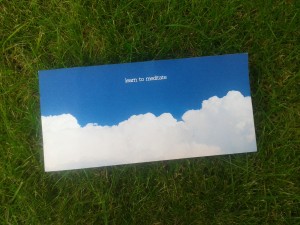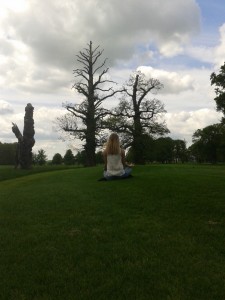“What is Meditation?” I don’t know. But it’s better than sitting around and doing nothing. Hannah Ketchin finds out more:
Ohhhmmmmm – Meditation is definitely catching on. I keep reading about it and hearing of people experiencing mindfulness on their lunch break. Earlier this month Parliament even had a go at an all-party group exploring the potential of mindfulness. It’s like the new yoga – its everywhere and edging more and more into the mainstream. As an avid bandwagon jumper, I’m on to it and keen to know more – but where do you start? After some initial Googling I have realised there are a LOT of different types & methods and it’s all a bit intimidating for a newbie like me. So I thought why not start with one of the oldest? Vedic meditation has been practiced for over 5000 years and originates from ancient India. It is a form of mantra meditation that is usually practiced for 20 minutes twice a day. As a starting point I went along to a free taster session with Will Williams (www.willwilliamsmeditation.co.uk), a qualified Vedic teacher. The small, relaxed session started off with a discussion about Will and other attendee’s experiences of meditation and a bit of history and background to the Vedic method. Will then went on to explain the mechanics of the method, telling us how the Vedic method is based on each individual being prescribed a specific mantra by their meditation teacher. The mantra has no inherent meaning and is simply a verse of sound that is not spoken or chanted aloud but silently repeated in your head. Once you are prescribed the mantra all you need to do is sit comfortably, no straight spine lotus pose required, close your eyes, start the mantra and wait to be taken away to a place of dreamy calmness. Will also talked us through the benefits of meditation, which are hugely appealing, especially when you live in a city like London where it just seems there is never any stillness; the pace of life is fast, busy and often puts people into a stressful mode which is an unhealthy way to live. Mediation if practiced regularly claims to:
- Reduce stress
- Improve your sleep
- Offer relief from anxiety & depression
- Reduce the risk of heart disease by 47%
- Improve memory and concentration
- Increase energy levels
- Enhance creativity
All these benefits are great and definitely things I really hope to get out of meditating. What is even more appealing about practicing meditation is that doing it is free, natural and relatively simple (I think?). You don’t need to sign up to a monthly membership or take time out to attend a class. You can do it pretty much anywhere at any time. During the second half of the taster session with Will, he helped us all try out a bit of the Vedic method. Unfortunately Will didn’t prescribe us each our mantra, (more on how to get your hands on one below) instead we were all given a generic mantra to try. The 1st part of the meditation was guided by Will as he got us to concentrate on our breathing and how our bodies felt. Then it was up to us as he left us to silently repeat our Mantra’s. During this time I felt a few things
- At the beginning I became REALLY aware of pain in my ankle (recently sprained). But after about 5 minutes I didn’t notice the pain at all.
- I kept forgetting to do the mantra but I have no idea how long for. A few people also experienced this and Will explained that this was normal and that you should let the mantra drop you off ‘somewhere’ and when you realise you have stopped ‘saying’ it you just start again.
- I lost time – I really thought we had been ‘meditating’ for about 10 minutes. It turns out it was more like 25. This is the thing that I have thought about the most since the session, as I honestly never thought I would be able to sit still, eyes closed for 25 minutes without fidgeting, opening my eyes and just being really bored.
The taster session with Will was really interesting and I would recommend it to anyone like me who is interested in meditation, wants to know a bit more and is thinking of trying it out. After listening to Will talk about his own and his students’ meditation experience, it’s clear that the real key to Vedic meditation is being prescribed your ‘personalised mantra.’ It seems that once you get your hands on this you will have the tool that allows you to meditate properly, reap all the amazing benefits and access a whole world of dream calmness! However, to get this mantra you need to attend a workshop or 1:1 session with a Vedic teacher which costs quite a lot of money. For me this is where I struggle with this method and I feel like the taster session was a bit like having an unaffordable carrot dangled in front of me. Despite not trying the true Vedic method I did feel like I got something from the small meditation we did. I came out of the session feeling lighter and super relaxed! Vedic meditation might not be an affordable method for me but I am definitely still keen and interested to stick with meditation finding one that is affordable so I can reap the benefits on offer. The real selling point for me and probably is for many others is how easy it is to fit into your schedule no matter how busy you are. One girl in the taster session told us how she meditated while on the tube adding that no one would have a clue that is what you are doing! In the pace of today’s society where we are all always working, exercising, blogging, tweeting, facebooking, networking, talking, consuming, doing etc. it’s good to set aside a few minutes a day to step back and take time out to be alone with your thoughts. In this world of no stillness, even a little calm goes a long way.
Written by Hannah Ketchin – new to blogging, but loves Health and Fitness Fads.


Leave a Reply